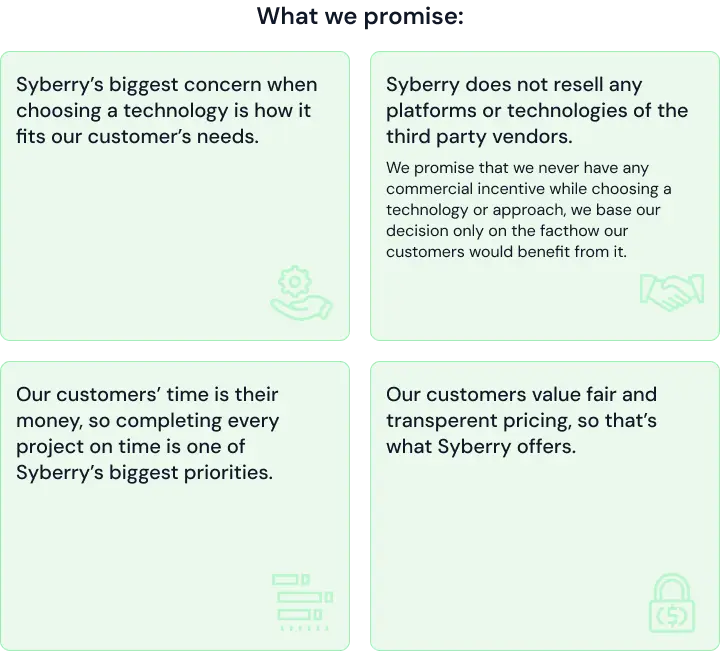Introduction
When you type ‘price transparency’ into a search engine, almost 90 percent of the returns will be related to healthcare price transparency, or the lack thereof. This isn't surprising, as the healthcare industry is famously opaque and affects nearly everyone in one way or another.
However, if we compare custom software development and healthcare, we may find a number of similar problems associated with price transparency and the heavy negative effect lack of transparency can have on the level of service and its value.
Inconsistency around pricing
The first problem is inconsistency, and there is likely no industry with as radically varied pricing as healthcare, where, for example, one California hospital charged $10 for a blood cholesterol test while another hospital charged $10,169 for the same test. This is just one example of the non transparent pricing that has corroded trust in the healthcare system.
While the discrepancies in software aren't as dramatic, similar problems do exist. When we put ourselves in the shoes of a customer asking for software development service from a company like ours, we can see how difficult it can be to extract exact pricing, and it can be even more difficult to compare varying information from multiple vendors in order to make an informed decision.
It seems that the companies compete in terms of their marketing efforts, i.e. how they present themselves, but it's harder to determine differences in the quality of their service.
In contrast to these difficult-to-parse pricing examples, SpaceX recently formulated and published its pricing on its website, clearly and concisely, for all to see. Other players in the same industry, such as United Launch Alliance (ULA) keep their customers, primarily the US government, in the dark, simply sending bills with no forecasting or horizon? So, why the different approaches? Are SpaceX's services and results substantially different from ULA's? No. Has space exploration suffered as a result of SpaceX's clarity? Not at all. It has accelerated considerably.
Obviously, price transparency is not the only factor here, but at least the taxpayers know now that space exploration can and will work in much more cost-effective manner, without compromising safety or the United States' position as leader in space exploration.
The software development industry suffers from the same illness ULA suffers from: nontransparent and ever-expanding costs. We should try to recall the notorious healthcare.gov portal, for which pricing grew ten-fold compared to initial estimates.
Unfortunately, this pricing creep is not only for government contracts. For one thing, pricing in our industry is a complete nebulous mess. Usually, there are pricing ‘segments’ companies fall into depending on their location (e.g. India, Eastern Europe, or the US), size, portfolio, specialization, and ability to pitch their services, including social and language skills. Furthermore, we see too many commercial contracts expand 20 to 250 percent from their defined scope. How is this possible?
Well, first, many software development companies may be afraid to give potential customers the full financial picture, thinking that if they reveal their full pricing strategies, another competitor may undercut them and win the contract, only to expand their scope once the client has signed on the dotted line.
Additionally, a salesperson may assign a price tag to a specific project based on his understanding of how much a customer is willing to pay, regardless of what it's actually worth.
Another problem we see is that many potential vendors simply do not have enough expertise to calculate pricing effectively. This is reflective of the company's inability to accumulate expertise and apply it to new project estimates. Instead, they rely on guesswork to quote each project, estimating from scratch rather than precedent, or they lowball to win the contract, giving an unrealistically low pricing only to surprise the customer with bigger numbers later.
As a result of all these issues and more, when a customer tries to break down the price of software development services they need, the landscape is anything but transparent.
This is one of the reasons many customers struggle to trust software development vendors. They don't hear the full truth about pricing (or even the truth that the pricing cannot be fully defined at that time). Instead, vendors tell potential customers what they think they want to hear in order to secure the contract, then surprise them later with the reality.
We believe this obscurity is wrong, and we would like to be much more transparent with pricing. On one hand, our transparency may enable competitors to use our own information against us, pricing their services based on ours. You might imagine it's like to appear naked before others who are fully dressed. But pricing transparency is deeper than that, and in the long run, we are fully confident that our transparency won't disadvantage us at all.
We know what our services and the quality of our results are worth, and we know how to explain our unique value to our potential customers.
Benefits of transparency in pricing
Why might a software company benefit from transparent pricing? While of course there are many customers on the market who only care about the big number, we assume that a customer applying to us is ready to listen and be receptive to our value as it supports the bottom line. Here's why:
It builds market knowledge and reduces uncertainty
When you go to a grocery store, you know what most of the goods you're looking for are, and you navigate pricing easily, ready to pay more or less depending on the brand, how much you like a product, and its value. You have the knowledge, and your uncertainty is low.
You may not know as much about the software industry, but you can still gather knowledge to reduce that uncertainty, especially when potential vendors are offering transparent pricing. As long as you understand that you should compare apples to apples when buying software development services, you'll find the right apple for you.
Consider not only cost, but a variety of other factors, as well, and build your knowledge and understanding of the market. Pricing is the reflection of a vendor's experience, reputation, domain expertise, and willingness to help customers.
It emphasises value not prices
The key essence of price transparency is the perceived value of the services a vendor is offering. Consider buying a car: every car does its job, transporting you from point A to point B, and yet customers pay more for some than for others. Why? The perceived value of each brand, and the experience the vehicle, manufacturer, and dealer offer in return.
Price transparency in the software industry works the same way. When the whole picture of pricing and what goes into it is available and a customer can see the expertise and experience a potential vendor brings to a project, it's easy to take value, price, and other supporting factors into consideration to make an informed decision.
It forces you to up your pricing game
A commitment to price transparency gives you advantages with customers, but it also forces your business to make improvements, as it reveals the weaknesses in your value proposition.
It may not be easy to see and accept development opportunities but, just like seeing the full picture helps potential customers make informed decisions, seeing the full picture here helps your business clearly see how to improve tactics and strategies, setting you up for greater success in the long run.
Nobody is perfect, and being able to openly perceive necessary changes is an advantage, not a drawback.
Improving price transparency
Lack of transparency in pricing is closely related to scope creep, as ambiguity in pricing is usually caused by ambiguity in the scope of work, which leads to uncontrolled expansion of the project's features, cost, and timeline.
When it comes to defining project pricing estimates, our industry utilizes two approaches: scope-based and capacity-based contracts. In the former case, vendors bid on a specific, well-defined scope of work. In the latter, they provide a team of people of certain qualifications to run the work based on the client's general objectives and instructions.
Most companies avoid scope-based, fixed-cost contracts at all costs, preferring low-commitment, long-term ‘time and materials’, or capacity-based contracts. These offer the vendor significant flexibility, but they also provide less certainty for clients and are prone to scope creep.
At Syberry, we prefer fixed-cost contracts because they offer more certainty to our customers and because our business practices allow us to create them effectively. In many cases, we are able to provide a customer with a fixed-cost quote just because we take time to dive into details of the project before providing a price estimate.
If the details we get from a potential customer upfront aren't sufficient, we have an option to run a thorough preliminary discovery phase to put together the ‘blueprints’ of the project. Having details and experience allow us to be fully transparent with our client, down to the smallest components of the quote and recommended approach.
How can you tell a vendor is committed to price transparency?
It's not easy, after all, for a vendor to be able to transparently quote a fully custom project that's being designed and built from scratch. Nor is it easy for a buyer to vet a quote when he doesn't have the vendor's technical expertise. Let's take a look at the components of transparent pricing to look for in your search for the right vendor:
They clearly convey all elements of pricing
A software project may have incremental costs per feature, including a number of activities that are absolutely necessary to produce quality software, such as QA. A transparent vendor will itemize each cost and be able to clearly and thoroughly explain each one's value.
Their prices are indexed from a concrete baseline
A vendor's baseline price should reflect hourly rates for labor, and that should be clearly and openly communicated to all potential customers, with any adjustments for specific types of customers or industries spelled out.
The next layer in the baseline price is the approximate cost of similar projects, which helps make the customer aware of the order of magnitude and budget considerations while planning.
The third layer is any necessary price adjustment based on factors such as the deadline for the release and the complexity of the minimal viable product, which will help to further define priorities and may trigger pricing changes in correlation with any mutually determined scope change.
A vendor who is committed to transparency will be able to explain how each piece of the price is derived from these baseline levels.
They can demonstrate differences in product profitability and lifecycle
The pricing approach should be clearly value driven, and a vendor should be able to help a customer identify the long-term financial and operational impact of developing a project in a certain way.
We, as developers, cannot tell a customer how to build another Uber, but what we can do, based on our experience, is tell them how to avoid typical pitfalls, how to implement something in a more efficient manner, what their audience may like, and what they may not.
This is closely tied to the lifecycle of the product and recommended investments in each stage which implies a transparent financial picture as a foundation for effective business decisions.
In other words, the right vendor will be able and willing to explain not only what a project costs but why it costs that much, and what kind of value comes with that price tag.

Our pricing transparency is a core part of the promise we communicate on our website. And we've also created a clear picture of our hourly rates and the activities included on most projects.
Just like SpaceX did on their website, we added a few parameters that may impact pricing, and we also added typical breakdowns for the most common types of projects.
We see price transparency and clear communication with customers as a part of our commitment to be helpful, open, and professional with any job we are doing for our clients.
If you're looking for a trusted partner to drive your next custom software development project forward, contact Syberry and tell us about your business goals.



